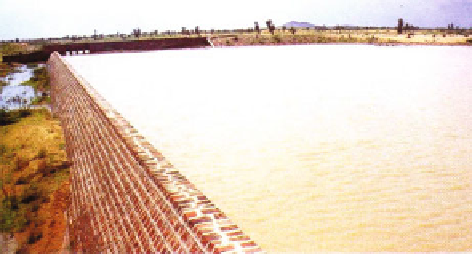Agriculture Reference
In-Depth Information
Fig. 5.6
Impounding water
with a stop dam
to the terraced check dams, used in streambeds of lesser slopes, these check dams
will store water for a little duration and collect more soil upstream. The upper few
courses should be alternately made of mulch-and-soil, and stones; and the top course
should be overlain with clay, mulch, peat, and brushwood, so as to make it almost
impermeable. The toe on the downstream side should be pitched for a few metres
with two courses of masonry.
Check dams may be encased in a wire mesh in streams having rapid flow and
high discharge. Such works serve the purpose of river-training and guide banks apart
from acting as check dams. Galvanised-wire woven mesh or chain-link netting is
used to bind the stone structure so that the entire structure acts monolithically. Such
a structure is called a gabion.
Check dams should be watched for damage by a downpour and their response
and effectiveness should be assessed. It is very difficult to predict the behaviour of
a check dam, since each stream has unique dynamics. The amount of discharge,
quantity of silt load, and the speed of flow determine the force associated with water.
If check dams are damaged outright, their design should be reconsidered, and then
repaired or rebuilt accordingly. If only incidental damage is seen, the same should
be repaired.
Timely repairs will make the check dams more effective and long-lasting. After a
few initial repairs, the check dams will become stable as a result of soil deposit which
will act as a binding material. When sufficient soil has been deposited, vegetative
barriers should be raised on it.
5.10
Stop Dams and Weirs
Stop dams are water harvesting structures built in stone masonry in cement-sand or
lime-sand mortar to impound water (Fig.
5.6
). Once the proper engineering design
has been selected (Fig.
5.7
) and alignment marked in the field, their construction
begins with excavation of the foundation. If the desired depth of foundation cannot
be excavated due to sheet rock, the foundation may be anchored to the base rock by
driving steel reinforcement into ground and letting them run through the masonry.

Search WWH ::

Custom Search